INTRODUCTIONThis paper is aimed at analyzing various verses from Jain Annals that tend to explain the structure of space and time in this theology.
The specific purpose of this paper is to explain that the current interpretation of Jain annals, which claims that planet Earth is flat with Mt Meru in its center, and two sets of sun and moon roving around it is wrong. This paper then presents an alternate model, which is in sync with the findings of modern science and is also in tune to the message of the scriptures.
Since the day science proved that our earth is not flat and that it revolves around sun, we Jains have been in intense debate over the structure of the universe as presented in our annals. It's because the structure, as we have been interpreting based on descriptions of our annals does not match the finding of the science.
This has created a rift in the Jain circles. The analytical nature of our theology does not permit us to accept any believe that does not support rational analysis. But at the same time, we find it hard to refute the words of Jina as He was an omniscient, and thus cannot be wrong.
The above findings, and their mismatch with the current interpretation of Jain annals tend one to conclude that either:
This paper is an attempt to introspect the annals and introduce an alternate model that is based on the Sutras of Jina, and is also in sync with modern science and its findings. This model tends to convey that the current interpretation of Jain Sutras on cosmology is wrong on below points:
This paper tends to conclude that
WHY SHOULD WE REEXAMIN THE VERSES ON TIME AND SPACE
1. Why is it important for Jains.A Shramana[4], by the very virtue of the fundamentals of this theology, cannot believe in any believe which fails the investigation of scientific findings or rational analysis. This is because such a belief, just based on reverence to someone is regarded as blind faith and is called Vanyik Mithyatva[5]. As per Jina, the stepping-stone of spiritual growth referred to as Samkit[6], is not possible to achieve till the person lives in any type of Mithyatva[7].
Thus either Jains need to be right on all verifiable scientific and rational analysis, or this religion falls under its own weight.
Furthermore no intelligent person would ever believe in the non-verifiable claims like existence of heavens and hells, or the concepts like Karmas[8], Samvar[9], Nirjara[10], Moksha[11] etc., if the verifiable claims of that theology have already been disapproved?
So it's of utmost importance for Jains to solve this riddle.
2. Why should scientific community pay and attention to what Jina said about this cosmos?
Jain annals refer to existence of three such substances in universe, which are relatively very new discoveries of science. These are Pudgal[12], which is same as matter, Adharma-Dravya[13], which is same as gravity & Dharma-Dravya[14], which is same as dark-matter.[i]
The SimilaritiesMention of these substances in annals that are around two thousand six hundred years old is no ordinary feat. If the preceptor of these annals was right about them being the constituents of this universe and responsible for its operations, then there is no reason why He would be wrong about the balance things that He told about our cosmos.
Thus solving the mystery of Jain cosmology is very important as in it may lay burry some still unknown facts about our universe and thus they can act as a guide towards further exploration of the same.
Before proceeding further, it's important to understand the similarities of the above marked three substances with modern scientific findings as it will help us in solving the puzzle of Jain cosmology.Pudgal & Matter
Adharma-Dravya & Gravity.The word pud means to add and the word gal means to subtract. Pudgal has been defined in Jain annals as a substance that exhibits the property to fuse or to break up. This property of adding up or fusion or breaking apart or fission is the central most trait of matter.
Furthermore, pudgal like matter, in Jain annals is defined to be made up of parmanus, which is defined as the smallest possible unit the matter could be broken into. Thus pudgal can be described to be same as matter.
Dharma-Dravya & Dark-matterExplaining Adharma-Dravya, Jina says:
It permits the stability of matter in universe in just the same fashion as Earth permits the stability of objects over it."[ii]
Today we know that it's the force of gravity that leads to stability of objects over Earth and that its also the force that leads to stability of all the celestial structures up there.Thus the similarity between Adharma-Dravya and gravity is not hard to point and the same can be referred to as similar in nature.
THE MISTAKES IN THE CURRENT EXPLANATION OF JAIN ANNALSExplaining Dharma-Dravya Jina says:
"Just as in this world water acts as the medium of motion for the fishes; similarly in this universe Dharma-Dravya acts as a medium of motion for matter."[iii]
Jain annals further claim that unlike matter, this substance is
"Devoid of attributes of taste, color, smell, sound, & touch. It pervades the entire universe, is one piece, huge & is at all points."[iv]
Today we know that it's the dark-matter that leads to movement of matter and that it's a special type of matter which pervades the entire universe and does not exhibit any property of matter like taste, color, smell, sound, touch or mass.
Thus on the basis of the above similarities, it can well be established that the substance which science refers to as Dark-matter is the same as Dharma-Dravya described in Jain annals.
The understanding of these above similarities will help us understand the structure of this universe as described by Jina The omniscient.
Reason for these mistakes1- Interpreting Bharat Kshetra as geographic India
Shri Jambudvipa Pragyapti Sutra marks the Bharat Kshetra as a region of Jambudvipa that has following characteristics:
Now if we compare this description with the geographic India, then in spite of a fake resemblance, in general this description does not match. If we equate Himalayas with Mt Chul-Himvat, Deccan plateau with Mt Vetadeya, the Indian Ocean with Lavana Ocean and Mt Aravali with Mt Rishab-Koot, then the river Ganges does not flow north and south of Deccan Plateau as described above. Furthermore the southern India is not exactly semi circular and is more of a triangle shaped peninsula. Furthermore the Aravali ranges are not in the center of northern India as described above.
The description of geographic India has not changed in past 2600 years, and Jina, being the son of a king, would certainly be educated of geography of the area where He was born. If He was describing the geographic India as Bharat-Kshetra, then He could not have done such mistakes.
Thus it can be said that the Bharat-Kshetra is not the geographic India.
2- Equating Jambudvipa with planet Earth
Shri Jambudvipa Pragyapti Sutra clearly marks Jambudvipa as a separate entity then our planet Earth.
Jambudvipa is referred to as an island and not as a planet. The Sutras that define this island states as under:
Jambudvipa is the first among all the islands and is situated in the center of the middle world. It's the smallest among all the islands and is complete round like a moon or the wheel of a chariot.[ix] [x]
Now if we analyze our Earth with the above description, there is no match. It's not the first planet in any sense. It's also not the center of our universe as our solar system is located in just a far off corner of our galaxy. Furthermore, there is no central mountain of our planet.
Thus the two can't be referred to as equal and all explanations that seem to suggest so are faulty.
What's the proof that Jina would have used metaphorical figure of speech to explain us the celestial structures?Jina was an omniscient, and because of this virtue, could clearly see how this universe is and the way it operates. However the persons to whom this knowledge was being imparted, were not so. Thus the terminology He would have used should be such that it's possible for the audience to visualize and comprehend what's being talked about.
Say for example, if we need to explain how an airplane looks like to someone who has never seen one, then in most likelihood we will explain it using the example of a bird. It's because an airplane exhibits a lot of properties like a bird. However it does not make airplane a bird in the literal sense of the word and if the person who is thus explained, starts believing that airplane is a form of a bird, then he will be grossly mistaken.
The same probably is the mistake we Jains have been making from long time. Jina used certain terms to explain us how certain celestial bodies look like, but we took them literally. Say for example the term "island." Jambudvipa has been referred to as an island. When Jina would have used this word, then He would have meant to say that it looks like an island in the Ocean of space and didn't actually mean to say that it's an island of continuous landmass in literal sense of the word.
Today as we see the outer space through our telescopes, we see that this universe is made up off various galaxies and they look like islands in outer space. If we could somehow move beyond our universe and see how it looks from there, then probably, it too will look like an island in the middle of Ocean of empty space. Thus when Jina would have referred that the middle world is made up of various islands, He probably would have meant that this universe looks like made up of various island like celestial structures. But since we humans took this term literally and assumed that these structures are continuous stretch of landmass, we misinterpreted the whole structure.
There is a Sutra of Jina that reads as under:List of Metaphors used to explain celestial structuresJust as it's not possible to explain a concept to a non-Aryan without using a non-Aryan language, same way it's not possible to explain the concepts of beyond (Paramarth) without practical (vyvhaar) point of view.[xi]
Thus, based on the above Sutra, it may be said that for Jina, the words were not as important as the concept or message that He wished to convey. Thus there is every possibility that the words like island (dvipa) that He used to explain celestial structures were just metaphorical representations of celestial bodies and not literally what these words mean.
IslandBelow are the few of the metaphorical terms used by Jina that we will be using in this paper along with probable explanation of what they really would represent.
Sun, moon & starsJina refers to existence of various islands that constitute the middle world. As discussed above, it doesn't mean that they are a stretch of land as the islands we see here on our planet. This term was used by the omniscient to describe a concentration of matter (pudgal) at specific portions of space similar to galaxies.
Thus when ever the term island appears, it should be read as a concentration of matter (pudgal) caused because of a force of gravity (Adharma-Dravya) central to that specific concentration.
MountainJust as sun moon & stars visible from our planet represents a set of all visible celestial bodies, same way when Jina uses this phrase, it should mean to express all the celestial bodies visible in space from the surface against which its referred to.
Just as mountains are the single greatest structure on our planet, same way Jina would have used this word as a metaphor to define some huge and massive celestial structures of our universe, which is gigantic in proportion to other celestial bodies in that region (island).River
OceanRivers divided the landmass into various regions and act as natural frontiers to them. Same way Jina would have used this word metaphorically, to define certain sections of our universe that divide a region into various portions. Furthermore, just as rivers help carry goods from one part of a land to another, rivers as defined by Jina in outer space are probably vast unrestricted sections of Dharma-Dravya (dark-matter) that help in transportation of matter (and soul) from one section of the region to another, unhindered by any gravitational pull (Adharma-Dravya) of any other celestial body.
FortJust as on our planet, Oceans are a massive stretch of water that divide one continent from another, same way Jina would have used this term to explain vast stretches of nothingness in outer space. These must be regions which have no other substance or almost negligible amount of any other substance, except for dark-matter (Dharma-Dravya).
THE SUTRAS REEXAMINEDForts are the frontiers of any region that hinder access into them. Thus when Jina used this term, He should have meant a natural frontier that prevents entry into specific regions of the universe. They must be different from giant celestial structures like mountains, or massive wide stretches referred to as rivers and also from vast stretches of nothingness referred to as Oceans above. In most likelihood, they could be massive rings of asteroids or comets that circle specific regions and thus pose as a natural hindrance for entry into that region.
Now, with the above explanations of various terms used to define various regions of outer space, lets start exploring what Jina had to say about our universe.The Middle World[15]
Jambudvipa The Island of Roseapple TreesA general view that Jain annals give of this universe is as under:
a) Mt Meru is at the center of the (middle) world surrounded by Jambudvipa, in form of a circle (like the wheel of a Chariot), forming a diameter of 100,000 yogans.[16] There are two sets of sun, moon and stars revolving around Mt Meru. While one set works, other set rests behind Mt Meru.[xii]
Now, if we visualize the middle world as per the description above, then the image that appears is similar to our solar system, with sun in it's center and planets roving around it. Or just like that of our galaxies, with black hole in its center and stars roving around it.
Same way, Jain annals claim that we have a huge celestial structure referred to as Mt Meru, right in the center of our middle world with gravity so immense, that it makes everything that exists in the middle world, be it stars, or galaxies, or even parallel universe revolve around itself is a fashion that (when seen standing over that mountain), only one set of them is visible at any point of time. Its this set of visible and non-visible universe that is referred to as metaphorical "sun, moon & stars" above.
To understand this structure of middle world better, we need to take the example of our planet Earth surrounded by celestial bodies (sun, moon & stars) all around. Just as when standing over any part of earth, we happen to see the celestial bodies only above us while the other set rests behind the surface of our planet, same way, in middle world, if we stand over the surface of Mt Meru, then at any point of time, just one set of celestial bodies (the metaphorical Sun Moon & Stars) are visible as the other sets behind the surface of Mt Meru.
This, first among all celestial structure, with a massive Mt Meru in its center, and two sets of celestial bodies roving around it is referred to as Jambudvipa. Lets represent it with "Diagram A" as attached below.
Jina says:Bharat-Kshetra Our homeb) Jambudvipa is the first among all the islands and is located in the center of the three lokas (heavens, middle world & hell). It's the smallest among all the islands. Is round like a full moon (or the wheel of chariot). Has the diameter of 100,000 yojans .and is surrounded from all sides by Fort Jagati.[xiii]
The above Sutra claims that the Jambudvipa is exactly in the middle of all the three worlds. Lets remember that it's referred to as an island. As we defined above, island should be read as a collection of celestial bodies that is formed by the virtue of gravitational forces (Adharma-Dravya) of a super structure in its center. Jambudvipa is the first and the smallest of all such celestial structures (islands) that surround Mt Meru, and is round like a full moon or the wheel of a chariot.
So as per the above analysis, Jambudvipa is not a piece of a continuous landmass, but a celestial structure, which contain two sets of celestial bodies (referred to as sun moon & stars metaphorically in "Point-a" above).
Thus, Jambudvipa can be referred to as:
Whatsoever it may be, it's not a piece of land, but a celestial super structure. We will try and decipher what among the above three (galaxy, universe or a multi-verse) is its exact structure as we proceed.
Furthermore, Jina claims that Jambudvipa is surrounded by Fort Jagati. This must represent rings of asteroids and comets, which is so dense that it acts like a fort that protects this island.
The Time AngleJina says:
c) (within this Jambudvipa there is a Bharat-Kshetra) It's south of Mt Himvant, north of Southern Lavana Ocean, west of eastern Lavana Ocean and east of western Lavana Ocean ..[xiv]
The above Sutra presents that amid the celestial bodies of Jambudvipa, which surround the Mt Meru, there is another mountain referred to as Mt Himvant.
Since Mt Himvat is a part of the celestial bodies (metaphorical sun, moon & stars), then as per "Point-a" above, it must also be roving around Mt Meru. To the south of this Mt Himvant, lies the section of Jambudvipa that is called "Bharat-Kshetra". (It's the part of the universe where we live). This section of Jambudvipa is surrounded by Lavana Ocean on its balance three sides.
We discussed above that Oceans have been used as a figure of speech by Jina to define vast stretches of nothingness or space, which have no other substance, or just negligible amount of any substance except for dark-matter (Dharma-Dravya). Thus it can be interpreted that Bharat-Kshetra represents the end part of the celestial island called Jambudvipa and beyond it, towards south there exist a massive stretch of empty space referred to as "Lavana Ocean".
Jina further describes Bharat-Kshetra as under.
d) ..In the center of Bharat-Kshetra, there exist Mt Vetadeya which divides the Bharat-Kshetra into two half's. There also exist two rivers named Ganga & Sindhu that further subdivides the region into three parts each side of Mt Vetadeya. Collectively, Bharat-Kshetra constitutes just the 190th part of Jambudvipa.[xv]
From the above verse, the structure of Jambudvipa starts taking shape. The metaphorical sun, moon and stars referred to at "Point-a" above, now starts revealing their true nature. The southern most part of this island is described to have another mountain called Mt Vetadeya, which due to its gravity (Adharma-Dravya), keeps the Bharat-Kshetra in shape just the same way as Mt Meru does for the whole of Jambudvipa.
Thus it can be called that Mt Vetadeya forms a sub-island within the island formed by Mt Meru. And since the metaphorical "sun, moon & stars", or in other words, all the celestial bodies that surround Mt Meru revolves around it, thus it may be called that Mt Vetadeya also revolves around Mt Meru and in this process also makes Bharat-Kshetra rove around the same.
Thus we can refine the Diagram-A we discussed above adding the info we have received so far. Lets name this as "Diagram B" as attached.
Note the term "river" used above. As discussed above, this should represent sections within Bharat-Kshetra, which are devoid of any Pudgal (celestial bodies, matter) and thus offer unrestricted movement due to the forces of Dharma-Dravya (dark matter).
Jina then moves on to further describe the Bharat-Kshetra as being semicircular from south[xvi] and rectangular from north with another mountain named Mt Rishab-Koot in its northern portion.[xvii]
Thus the structure of Bharat-Kshetra could be defined as per "Diagram C" below.
As per Jain annals, Jina was born in this Bharat-Kshetra of Jambudvipa. So our planet should be in this part of the universe. But as we look around in our universe through our telescopes, we do not happen to see any super gigantic structures that can be called as Mt Vetadeya, which is claimed to be in the center of the Bharat Kshetra. If it's a celestial structure so huge, that it makes all celestial bodies rove around itself, then it cannot remain hidden. Nor do we see any specific sections of universe that could be metaphorically called as rivers. So how do we explain their presence?
Until a few decades ago, till the time science had not discovered that there were galaxies beyond our milky way, they assumed that our milky way is the only universe. But now, with the increase in our technology, we are able to see that our milky way is just one of the odd 100 billion galaxies out there. But till the point they actually discovered it, these 100 billion galaxies were regarded as non-existent. So, a proof of non-appearance of an object cannot be regarded as a proof that it does not exist.
Using the above rule, it can be said that probably it's also true about the Mt Vetadeya & the rivers mentioned by Jina. Mankind has yet to develop technology that could see far enough for these parts to become visible.
The above claim tends to convey that the entire universe which we see out there, is just one of the six parts of Bharat-Kshetra and as we peep down further into the space, we would eventually discover both metaphorical rivers and the mountains.
The above claim is indeed mindboggling. It tends to convey that the entire universe we see, with over 100 billion galaxies, is just one of the six parts of a region called Bharat-Kshetra of this mighty universe. This Bharat-Kshetra in turn is just the 190th part of a region of our cosmos referred to as Jambudvipa. This Jambudvipa in turn is just the first and smallest of many islands in the part of the universe that is referred to as middle world, where we humans and similar other alien races reside. This middle world in turn is just the smallest portion of this entire cosmos referred to as "Lokakash"[17] in Jain annals. (See "Diagram D" below).
Now this makes our universe really huge. Huge to a degree that just makes our imagination go haywire. It's so unfathomable that one might just want to dismiss the same as a mere assumption. But then lets not forget that this knowledge is an interpretation of Sutras of a person who explained 2600 years ago the concepts of gravity, dark matter and fusion-fission properties of matter. So before we dismiss the above Sutras, it's worth giving them further analysis.
The above model claims that middle world of this universe, the part in which we humans live, has a giant celestial structure referred to as Mt Meru in its center and the entire middle world revolves around it. This model tends to represent that this universe is revolving in nature. This model does make sense because everything in this universe seems to be revolving around something else. Be it moon revolving around Earth, or planets revolving around stars, or stars doing the same around their respective black holes. So at the first sight, the model of revolving universe does seems perfectly logical and reasonable.
However the current scientific findings seems to disagree and believe that this universe started from a singularity and is constantly expanding. The basis of this belief is the observation of red-shifts in the movement of galaxies. This observation tends to suggest that galaxies are moving away from each other leading to vindication of the belief that they started from one point and are constantly moving away from each other.
But if we observe this movement based on the above model of revolving universe, then this movement may simply be accorded to movement of galaxies on their own orbits, moving away from each other. Its also worth noting that some galaxies also exhibit blue-shifts which seem to suggest that they are moving closer to each other and will eventually collide. This may also just be a wrong assumption because the blue-shifts observed may be because of galaxies moving towards each other, but on their own respective orbits. [xviii]
I have tried explaining this phenomenon using "Diagram E" below. Thus it may well be said that the model of revolving universe is in tune with the findings like red-shifts and blue-shifts observed in our universe.
Other Celestial structures of JambudvipaFurthermore, this incomprehensible vastness of our cosmos is further supported by a similar immeasurable time spans in Jain annals. These time spans are measured using a special term called Palyopam[18]. It's span is calculated using the below method:
e) If a pit one yojan long, one yojan wide and one yojan deep is tightly filled with finest hairs of a new born, one to seven days old; then the time taken to empty this pit by taking out just one hair every hundred years is referred to as palyopama.[xix]
Now such a timeframe can be referred to as practically uncountable, but still it's not infinite. It's so because at some point of time, the pit will empty. As per Jain annals, Ten Thousand Trillion of such palyopama then makes one sagaropama. Together, these two special units of time (palyopama & sagaropama) are used in calculating the movement of celestial bodies (the metaphorical sun, moon & stars) across Mt Meru.
To sum up the discussion thus far, lets jolt down some of the findings we have made. These are as under:
Kala-ChakraBharat-Kshetra, the part of the world we discussed above, is just one of seven parts that constitute Jambudvipa. The Jain annals describe the balance regions as under:
f) Jambudvipa is divided into seven regions (Kshetras) 1) Bharat-Kshetra, 2) Airavat-Kshetra, 3) Haimavat-Kshetra, 4) Hairanyat-Kshetra, 5) Harivarsh-Kshetra, 6) Ramyakvarsh-Kshetra, 7) Mahavideh-Kshetra. (Also) there are six Varshdhar Mountains (which divide Jambudvipa into seven distinct regions).[xx]
We interpreted above that all the galaxies we see above, along with its yet to be discovered rivers, mountains & galaxies constitute just Bharat-Kshetra. Beyond this region there exist six more regions. Together these seven regions constitute the region of the universe that is called as Jambudvipa The Island of Roseapple Trees.
The above Sutra further claims that these seven distinct regions are created because of six Varshdhar Mountains. So collectively, this region should look like Diagram-F as attached. The Jain annal Shri Jivajivabhigam Sutra further claim that each of these regions (Kshetras) has areas that support intelligent human life forms along with animals, birds, insects and plants.
We discovered in "Point-a" above that all the metaphorical sun moon & stars that surround Mt Meru revolve around it.
In the "Point-f" above, we discovered that the metaphorical sun moon and stars being talked about are actually the various regions of this Jambudvipa, of which one part is referred to as Bharat-Kshetra the region where we Earthlings live. Thus, it may well be interpreted that Bharat-Kshetra, which includes our planet earth, also revolves around Mt Meru.
The Alternate ModelAnother proof from Jain annals that seem to suggest this revolving nature of universe is the theory of Kala-Chakra.[19]
Kala-Chakra is defined as a time span, with self-repeating, never-ending epochs, which our part of the universe passes through - unabated. These epochs are divided into two sets, with six each in the increasing phase of Kala-Chakra and six each in the decreasing phase of the same. Each of these epochs is suppose to have its own distinct characteristic that leads to changes in climatic conditions and resulting pleasures & pains in the whole of Bharat-Kshetra, including our planet.[xxi]
These conditions are so diverse, that at one point of time, our planet appears to be a living heaven, with conditions that resemble the Garden of Eden in the Abrahamic religions[xxii] and at some point of time it becomes so painful that our plants becomes like a living hell.[xxiii]
Now, if we analyze the possible reason of this never ending, self repeating epochs, then a proof of possible revolving nature of Bharat-Kshetra will not be difficult to interpret.
It's somewhat similar to self-repeating seasons on our earth. Today we know that the reason of the same is the revolving nature of our planet across the sun. Similarly, it may be possible that epochs change in a self-repeating cycle because of revolving nature of Bharat-Kshetra across Mt Meru.
One complete circle of these epochs is referred to as "Kala-Chakra". (see Diagram-G). The time required to achieve this complete circle is 20,000 Trillion Sagaropama.
Now, that's a huge amount of time. But when seen in relation to the sheer size of our universe (Jambudvipa), then the two seems in sync with each other and seem to support each other.
Mystery of two suns & two moons in Jain annals.Based on the above analysis of description of Jambudvipa and Bharat-Kshetra along with time scales mentioned in Jain annals and self repeating nature of epochs, it may be said that Jambudvipa referred to in these texts is actually a massive "island universe" with six distinct regions that houses planets which support intelligent human life forms. Each of these regions is separated by massive celestial structures referred to as Varshdhar Mountains. Collectively, this universe, with all its seven distinct regions, revolves around Mt Meru, and one such complete roving is referred to as Kala-Chakra.
References of other Island Universes in Middle WorldJain annals, in spite of using the terms like sun, moon & stars metaphorically, also specifically refers to existence of two suns and two moons in Jambudvipa. The below Sutra is a proof of this.
g) In Jambudvipa there are two moons, two suns & fifty-six nakshtras.[xxiv]
The above Sutra, unlike the "Point-a" we discussed above clearly point towards the presence of two suns and two moons.
Until now, based on the popular believe that Jambudvipa is our planet Earth, this Sutra led the Jain scholars to believe that there are two suns and moons that rove around earth and as the first sun sets, the next day it's the second sun that appears in sky and as the second sun sets, the first sun again appears the third day. They advocated the same theory for moon too.
The above believe has been proven to be completely unscientific and baseless by modern science.
However, if we interpret sun as a life giving star and moon as a satellite orbiting a planet with human population then the above Sutra can be decoded; as there may be more then one sun like star that supports life on a planet and there may be more then one planet with human life form with an orbiting moon around it.
The below Sutra supports this claim and explains that the second sun and moon being talked about, is not in Bharat-Kshetra, but in another part of Jambudvipa.
The Sutra states as under:
h) If we divide this Jambudvipa from east to west and from north to south in 124 mandals, then in 1/4th part of south-east and north-west of this mandal, and 800 yojans above this extremely memorable part of this "rattan-prabha prithvi" (planet), there appear two suns.[xxv]
Based on the above model, when we analyze Jambudvipa as an island universe, then the above Sutra clearly points out that the two suns being talked about are in two different areas of this island universe. The first (the one in the south-east) is in our part of the universe, the Bharat-Kshetra (which as per the "Point-c" discussed above is the southern most corner of Jambudvipa), and the second in the opposite part of it, and in most likelihood the Airavat-Kshetra.
Same way the second moon, being talked about in Jain annals, as per Shri Chandra Pragyapti Sutra is not in Bharat-Kshetra - the part of the universe where our Earth is situated.
So this above model of seeing Jambudvipa as an island universe solves the above riddle too.
CONCLUSIONOur "Island Universe", The Jambudvipa discussed above is just the first and the smallest of all dvipas (island universes) that constitute the middle world. Jain annals refer to existence of many more such islands that surround Mt Meru like rings, one after the other.
The first eight of these are as under:
- Jambudvipa,
- Ghatki-Khanda,
- Puskarvardvipa,
- Varunvardvipa,
- Kshivardvipa,
- Ghrutvardvipa,
- Ikshuvardvipa
- Nandishwardvipa.
Collectively, as per Shramana-Jain annals, all these island universes that rove around Mt Meru constitute the middle world. Above it lays various layers of heavens where demigods reside. Underneath it lays various layers of hells in which demons live. Collectively, these three parts put together are called "Lokakash". Beyond that there lays empty space referred to as "Alokakash".
These expansions are beyond the scope of this paper and thus are not being discussed here.
Based on the above analysis, it may be said that in Jain annals:ACKNOWLEDGEMENTS
A special thanks to Dr Jeoraj Jain, author of the book Lokakash Eik Vegyanik Anushalin & author of the paper "Scientific interpretation of Jain Lokakash Map".[xxvi] It was during my discussions with him on this subject in which he inspired me to write this paper. He also reviewed this paper and made some very important edits.

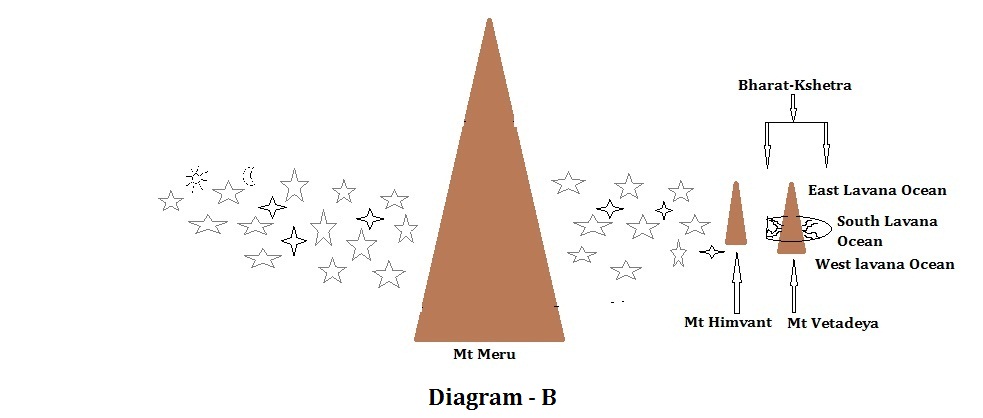
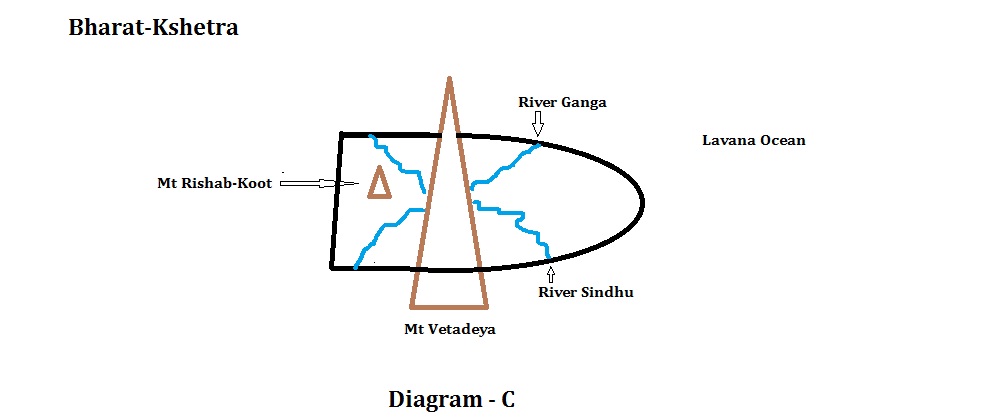
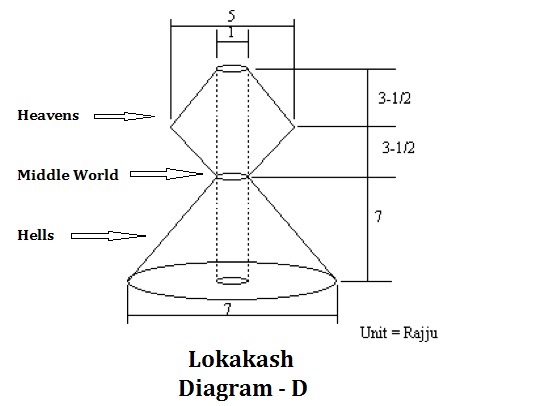
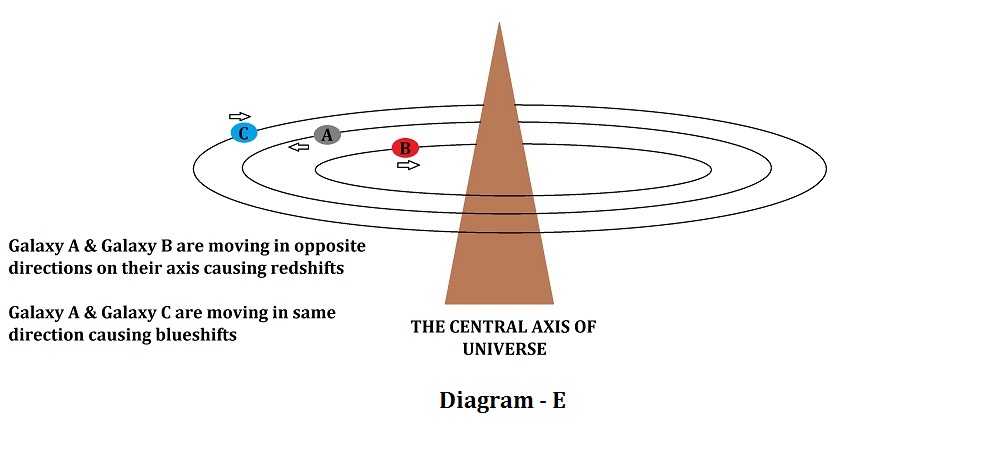
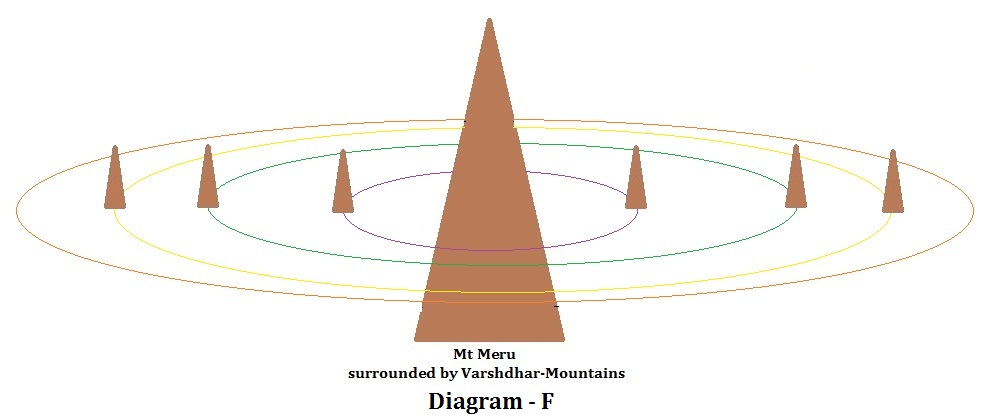
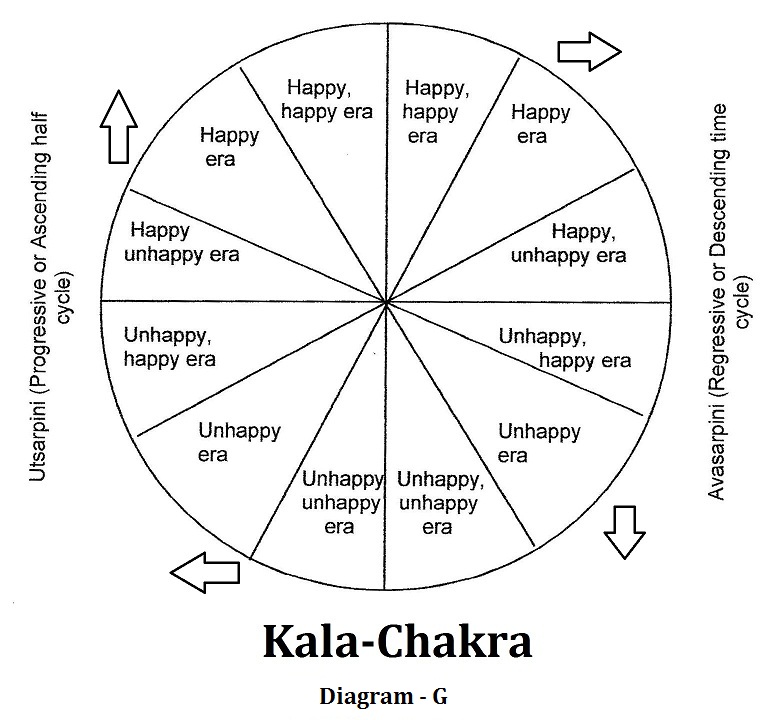
One of the six substances that constitute this universe. Shows the special property of fusion (pud) & fission (gal)
One of the six constitutes of the universe that provides the medium of motion for movable substances (matter & Jiva).
 Amit Jain
Amit Jain